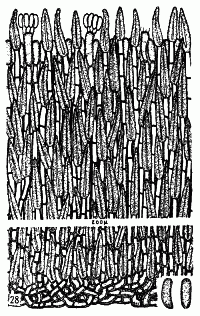|
 Hymenochaete magnahypha Hymenochaete magnahypha
BiostatusPresent in region - Indigenous. Non endemic
Images (click to enlarge)
Caption: FIG. 28. Hymenochaete magnahypha G.H.Cunn. Transverse section x 500; spores x 1000. |
Article: Cunningham, G.H. (1957). Thelephoraceae of New Zealand. XIV. The genus Hymenochaete. Transactions of the Royal Society of New Zealand 85(1): 1-51.
Description: Hymenophore resupinate, perennial, brittle, membranous, adnate, effused forming linear
areas to 25 x 3 cm. Hymenial surface chocolate with a grey bloom, even, at length deeply
irregularly creviced; margin thinning out, chocolate, crenate, closely adnate. Context
chocolate, to 500 µ deep, composed of many rows of overlapping setae embedded in scanty
upright cemented hyphae, with a delicate zone of compact hyphae lying upon the substratum;
hyphal system monomitic; generative hyphae to 5 µ diameter, walls 1 µ thick, dingy brown,
or fuscus, sparsely branched, freely and closely septate. Setae arranged in many overlapping
rows, projecting to 20 µ, subulate, 24-40 x 5-7 µ, walls coarsely verruculose, ferruginous,
lumina harrow. Hymenial layer to 30 µ deep, a scanty palisade of basidia and paraphyses.
Basidia subclavate or cylindrical, 20-24 x 5-6 µ, 4-spored; sterigmata arcuate, slender, to 5 µ
long. Paraphyses cylindrical, shorter and narrower than the basidia. Spores allantoid,
apiculate, 8-9 x 3-3.5 µ, walls hyaline, smooth, 0.1 µ thick.
Habitat: HABITAT: Effused on bark of dead branches associated with a white rot.
Distribution: DISTRIBUTION: New Zealand.
Notes: Specific features are the crowded small setae occupying the thickness of the context, large-diameter thick-walled cemented hyphae, and
large allantoid spores. Basidia collapse as soon
as spores are shed so are difficult to find save in growing margins. Immature setae of young
plants are hyaline, thin-walled, naked and simulate gloeocystidia even to the contents. The
surface colour is exactly the shade of weathered chocolate which has developed a greyish
bloom. The species most closely resembles H. vallata in surface features, differing in the
smaller setae, larger basidia and large spores.
|